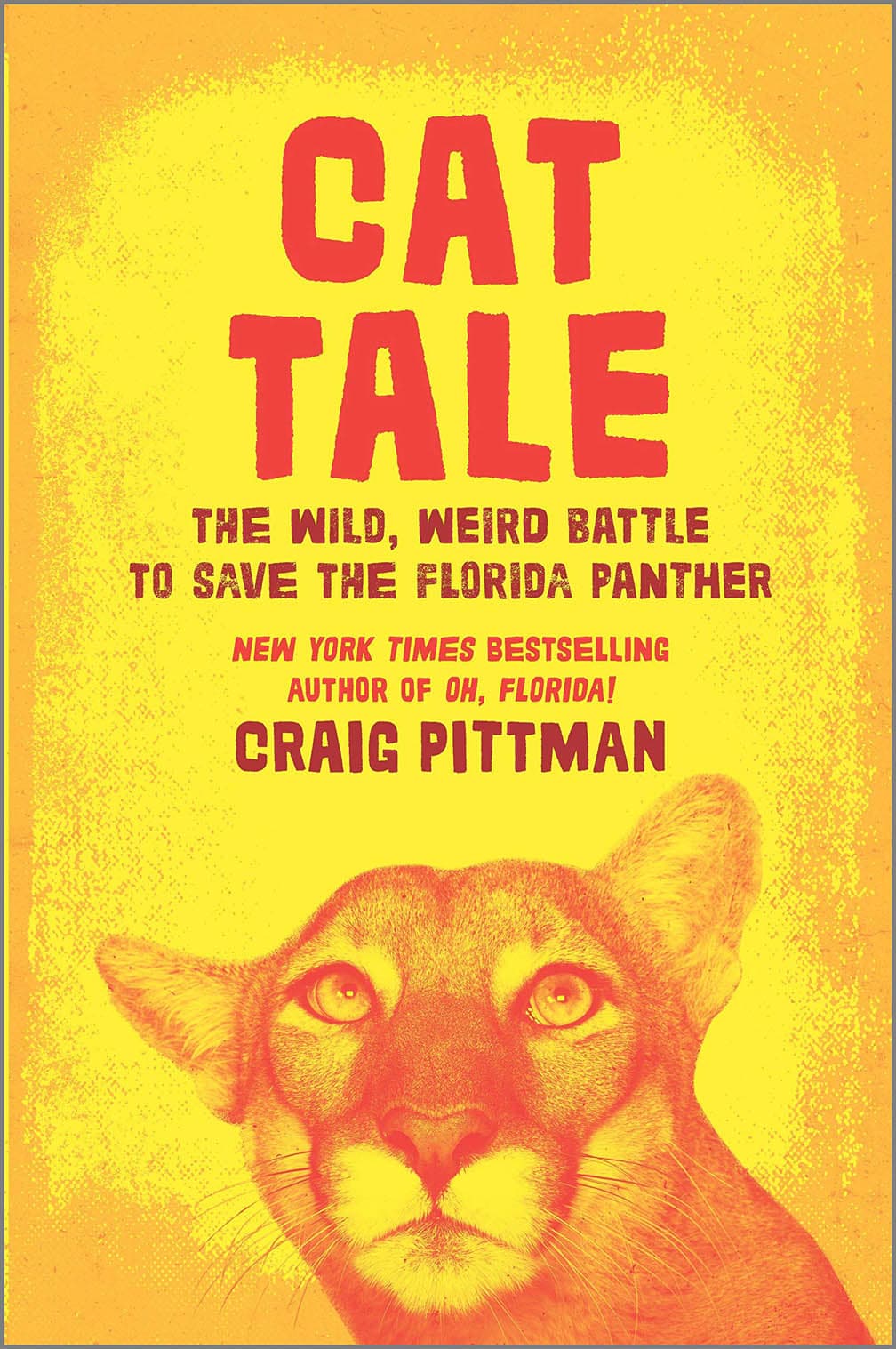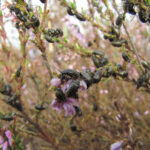Absent Wolves, Ecosystems Changed. Can New Wolves Restore Things?
The Florida panther’s unlikely comeback is neatly summarized on the website of the U.S. Fish and Wildlife Service. From around 20 surviving animals in the early 1970s (with the population possibly reaching as few as six), there are now more than 200 and counting. The agency credits this recovery to studious collaboration between federal and state officials, including the introduction of life-saving genetic diversity to the endangered panther population, as well as conservation of vital habitat.

BOOK REVIEW — “Cat Tale: The Wild, Weird Battle to Save the Florida Panther,” by Craig Pittman (Hanover Square Press, 336 pages).
What the official description doesn’t mention, however, is the drama, individual perseverance, and messy, sometimes blundering, realities that enabled the Florida panther to claw its way back from the precipice of extinction. For a full account of this swampy, fraught history, readers can instead turn to award-winning journalist Craig Pittman’s new book, “Cat Tale: The Wild, Weird Battle to Save the Florida Panther.”
More than a natural history monograph, “Cat Tale” is the story of Florida’s complicated relationship with its state animal. (This being Florida, and as Pittman suggests in the subtitle, there is also a healthy dose of weirdness sprinkled in, such as the camera trap that gets photobombed by a guy dressed as Bigfoot.) Humans have been and continue to be the main drivers behind the Florida panther’s decline and uncertain future. But as Pittman shows, they are also the reason the panthers did not go the way of the passenger pigeon, dodo, and Tasmanian tiger.
Florida panthers are a subspecies of Puma concolor, a big cat with more than 80 common names, including the puma, cougar, or mountain lion. The predators once stalked landscapes from Canada to Argentina, from the Pacific to the Atlantic, but their populations have been reduced to a sliver of their former range. Today, panthers living east of the Mississippi River survive only in Florida, representing less than 5 percent of their historic range.
They very nearly didn’t make it in Florida, either. European settlers valued panthers for their skins and also viewed them as a threat. Bounties accelerated the killing in the 19th century, and development during the next century picked up where the hunters left off, nearly wiping the cats off the map.
In 1950, amid warnings that panthers were going the way of other imperiled local species like the manatee, whooping crane, and ivory-billed woodpecker, Florida began regulating the cat as a “game animal,” meaning limits could be set on the number of the predators legally killed. Soon after — realizing that the animals had all but disappeared — the state banned all panther hunting. A few years after that, the subspecies joined the newly created endangered species list.
Although protected on paper, the panthers faced new threats in the coming decades, from an airport nearly built atop their last remaining habitat to all manner of bureaucratic corruption, greed, ignorance, and mismanagement. Pittman unspools these near-misses through exhaustive research and first-hand interviews with the surviving handful of biologists, veterinarians, and professional hunters who can ultimately be credited for the cat’s tenuous come-back.
The decades-long rescue effort at the heart of “Cat Tale” begins in 1974 when Chris Belden, a young biologist at the Florida Game and Freshwater Fish Commission, put together a team of scientists and trackers to confirm that panthers still even existed. From there, they moved on to the painstaking task of tracking and quantifying the animal’s numbers — and identifying the factors behind their collapse.
In 1985, game commission officials handed over leadership of the panther team to David Maehr, a biologist who had studied birds and bears, and who had worked for coal companies, but who had no experience with panthers. In Pittman’s telling, Maehr seems to have done more harm than good for the species, from cherry picking data to dismissing a brilliant female veterinarian’s warnings that inbreeding posed a mortal threat to Florida panthers.
Melody Roelke, the veterinarian, would likely have continued to be ignored, and the Florida panther genetically bottlenecked itself into extinction as a result, had a team of outside (male) experts not finally vindicated her in the late 1980s.
The first attempted fix, a botched captive breeding effort, nearly destroyed the species. But a desperate, last-ditch “Hail Mary” effort, as Pittman puts it — the importation of eight mountain lions from Texas, a closely related subspecies — secured the panther’s future. In 1995, two kittens born to one of the imported females and sired by male Florida panthers showed none of the telltale signs of inbreeding present in the few remaining Florida natives, including heart murmurs and problems with their reproductive systems. As the females gave birth to litter after litter, the kittens grew into adults that “freshened up the gene pool” and gave a crucial boost to the subspecies’ dwindling population, Pittman writes.
By this time, Pittman writes, Maehr had quit his job at the game commission and become an associate professor who made tens of thousands of dollars on the side consulting for developers, using faulty, self-produced numbers to justify paving over panther habitat. He was helped along by the Fish and Wildlife Service, which green-lit all the permits he put in front of it for years. In the end, from 1999 to 2005, the agency gave its blessing to develop almost 40,000 acres of panther habitat, according to Pittman’s analysis.
Throughout “Cat Tale’s” highs and lows, the message that resonates the most is how easily science can get lost in the tangle of human ego, motivation, and bias. Given the disheartening realities of how conservation actually works on the ground — of how money and personal gain so often trump data and the law — it may strike readers as a wonder that any endangered species, let alone Florida panthers, still exist at all.
The Fish and Wildlife Service estimates that 230 adult panthers survive in Florida today, and while this is a marked recovery, they are still one of the most endangered mammals in the world. The Florida panther’s future is not necessarily secure. Pittman points out that the cat remains confined to a single patch of habitat in the southern part of the state, leaving it vulnerable to disease, fire, invasive species, or any number of environmental or manmade disasters.
Meanwhile, roads, which regularly claim the lives of panthers that venture out of their southerly nook, prevent their natural expansion, while development — now the top threat to panthers — shows no signs of slowing. More than 900 people on average move to Florida each day, and Florida just approved three new toll roads that will cut directly through panther habitat.
Pittman ends his book on a hopeful note, though, with the birth of panther kittens for the first time in decades in an area north of the Caloosahatchee River. It could be, a source tells him, that these kittens and others like them will go on to repopulate the Southeast. But it’s going to take a lot more than hope, as Pittman makes clear, to secure that future for Florida panthers.
Rachel Love Nuwer is a science journalist whose writing has appeared in The New York Times, National Geographic, Scientific American, BBC Future, and elsewhere. She is the author of “Poached: Inside the Dark World of Wildlife Trafficking.”












Comments are automatically closed one year after article publication. Archived comments are below.
“They’re completely missing the fact that if you’re an elk and you’re found by wolves, you’ve got an 85-95 percent chance of living. Why would you quake in your boots?”
… Placed in the context of the COVID era, I think we can all see that this point is moot.
The theory that nature is permanently in balance has been largely discredited by scientists working in ecology, as it has been found that chaotic changes in population levels are common. During the later half of the twentieth century the theory was superseded by catastrophe theory and chaos theory.[6] Nevertheless, the idea maintains popularity amongst the general public.[7][8]
I have another quote, this one from Sir Aldo whom people like to quote like scripture, “Predatory animals affect four kinds of people 1. Agriculturalists 2. sportsmen 3. students of natural history (we’d call them environmentalists) 4 the fur industry. There is a certain degree of natural and inevitable conflict of interest among these groups. Each tends to assume that its interest is paramount. Some students of natural history (you) want no predator control at all, while many hunters and farmers want as much as they can get up to complete eradication. Both extremes are biologically unsound.
So.. Where is the wolf control? No state in the lower 48 has ever been able to implement science based wildlife management in the control of wolf populations, and they recieve no assistance from environmentalists to do so. Pick and choose statistics to prove a point, but in every state where wolves have been introduced anti wolf sentiment has only hardened. Every lawsuit cements opposition. We are outvoted, but then we end up with Interior Secretaries not to our liking.
You wrote, “. In Wyoming, Idaho, and Montana, elk populations are holding steady, though at lower levels than during the 20th century, when there were few wild predators to affect the population.” Here are the figures.
Wyoming – 1995 elk population = 103,448; 1995 elk harvest = 17,695.
2018 elk population = 110,300; 2018 elk harvest = 25,091; average hunter success rate = 44.8%;
Montana – 1995 elk population = 109,500, no harvest data for 1995.
2018 elk population = 138,470 (Objective 92,138) 2018 elk harvest = 27,793.
Idaho – 1995 elk population = 112,333, 1995 elk harvest = 22,437.
2017 elk populatio
n = 116,800 (18 elk units at or above objective, 10 units below for a variety of reasons), 2017 elk harvest = 22,751. 2018 harvest = 22,326. 2018 estimated population 120,000+.
While I appreciate the in-depth look into the complicated nature of this topic, I think that it is essential to note that the concept of “restoring the balance” resonates with a broad swath of the public. Is it an oversimplification? Perhaps. Is it a falsehood? No. Just as we can tease apart the assertion that human activity is the cause of climate change, revealing the nuances and oversimplified nature of the statement, the core truth remains.
Aldo Leopold’s famous quote from Round River bears repeating here: “If the land mechanism as a whole is good then every part is good, whether we understand it or not…To keep every cog and wheel is the first precaution of intelligent tinkering.”